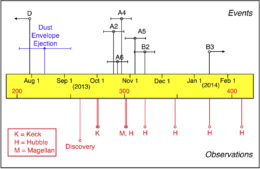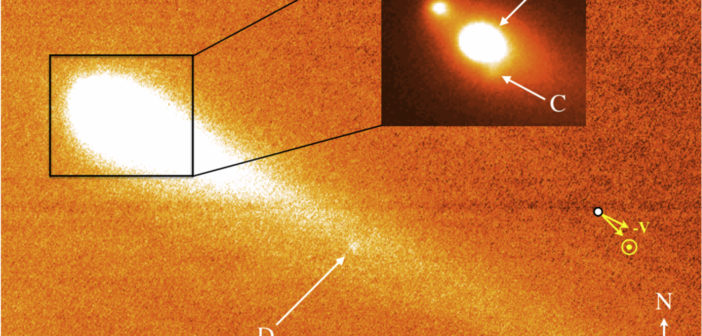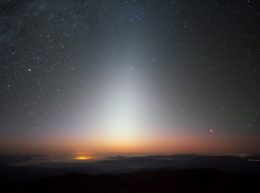A team of scientists has observed the breakup of an asteroid as it orbits the Sun. In a new study, they reveal what they’ve learned from their ground- and space-based observations of this disintegration.

These Hubble images show the fragments of R3 in higher resolution over the span of October 2013 to February 2014. [Jewitt et al. 2017]
Observations of Disintegration
Active asteroids are objects that move on asteroid-like orbits while displaying comet-like behavior. The cause of their activity can vary — ranging from outgassing as the asteroid heats up in its solar approach, to expelled debris from a collision, to the entire asteroid flying apart because it’s spinning too fast.
Led by David Jewitt (University of California at Los Angeles), a team of scientists has analyzed observations of the disintegrating asteroid P/2013 R3. The observations span two years and were made by a number of telescopes, including Hubble, Keck (in Hawaii), Magellan (in Chile), and the Very Large Telescope (in Chile).

A schematic diagram of the different fragments of R3 and how they relate to each other. Black numbers estimate the fragment separation velocities; red numbers estimate the separation date. [Jewitt et al. 2017]
Cause of the Breakup
The team found that P/2013 R3 broke up into at least 13 pieces, the biggest of which was likely no more than 100-200 meters in size. The original asteroid was probably less than ~400 m in radius.
By measuring the velocities of the fragments in the various observations, Jewitt and collaborators were able to work backward to determine when each piece broke off. They found that the fragmentation process was spread out over the span of roughly 5 months — suggesting that the asteroid’s breakup wasn’t impact-related (otherwise the fragmentation would likely have been all at once rather than gradual).

Timeline of the destruction of R3. Calendar dates are in black, day-of-year dates are in red. The letters below the timeline indicate observations. [Jewitt et al. 2017]
The authors conclude that the most plausible cause of R3’s breakup was rotational instability. If an asteroid is made up of a collection of rocky material loosely gravitationally bound in what’s known as a “rubble-pile” composition, then it tends to fly apart if the asteroid spins faster than once every ~2.2 hours. The authors show that torques from radiation or anisotropic sublimation could have driven R3 to spin this quickly on a relatively short timescale.
A Dusty End
Lastly, Jewitt and collaborators examine the debris cloud released by the breakup of R3. They use these observations to estimate how much debris disrupted asteroids likely contribute to the Zodiacal Cloud, the cloud of dust found in our solar system, primarily between the Sun and Jupiter.The authors estimate that the fractional contribution by asteroids like R3 is roughly 4% — consistent with models that suggest that asteroid dust is a measurable, but not dominant, contributor to the Zodiacal Cloud. Future sky surveys will allow us to better examine this contribution.
Citation
David Jewitt et al 2017 AJ 153 223. doi:10.3847/1538-3881/aa6a57



4 Comments
Pingback: Anatomia de um colapso de um Asteroide | EXOSS Citizen Science Project
Pingback: asteroid breakup
Pingback: Anatomy of an Asteroid Breakup |
Pingback: Anatomy of an Asteroid Breakup – New